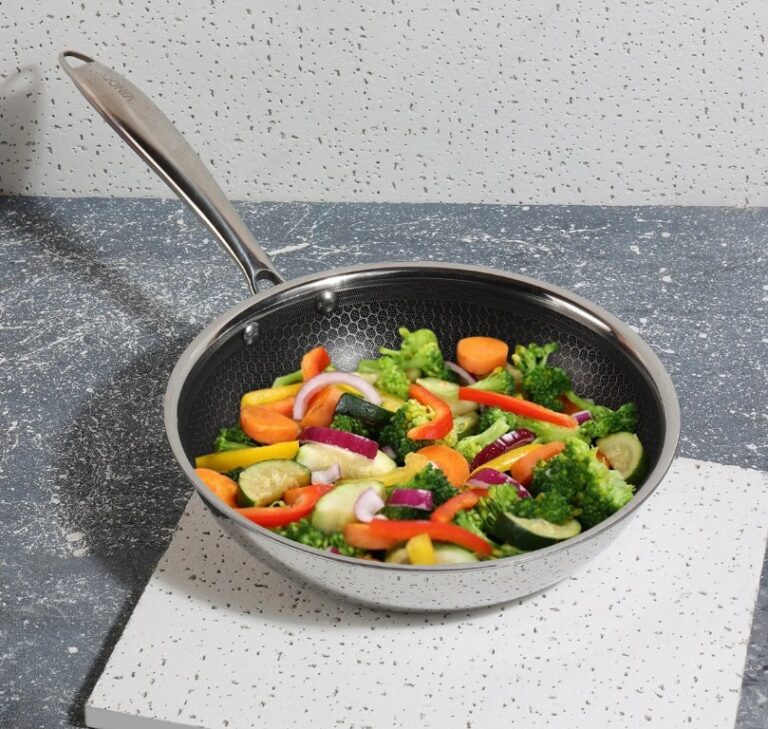When it comes to Indian cooking, having the right cookware is just as important as the spices and ingredients you use. Among the many utensils that grace an Indian kitchen, the kadai and stainless steel pan stand out as indispensable tools. Each brings unique advantages, making them perfect for a variety of traditional recipes—from deep frying crispy snacks to sautéing fragrant masalas.
Mastering the use of both the kadai and stainless steel pan can significantly enhance your culinary skills and help you achieve authentic flavors and textures that Indian cuisine is famous for.
What Makes the Kadai Special?
A kadai is a deep, round-bottomed cooking pot traditionally made from cast iron, aluminum, or stainless steel. Its distinctive shape with high sloping sides and a flat or rounded base is designed to hold heat evenly and allow for versatile cooking techniques.
Why Indian Cooks Love the Kadai:
- Perfect for Deep Frying: The deep sides prevent oil splashes, making it safe and efficient for frying snacks like samosas, pakoras, and puris.
- Ideal for Stir-Frying and Sautéing: The wide opening provides ample surface area to toss ingredients, ensuring even cooking and quick evaporation of moisture.
- Retains Heat Well: Traditional cast iron kadais distribute heat evenly and maintain consistent temperature, essential for slow-cooked dishes like curries and bhartas.
- Versatile for Various Dishes: From preparing masalas to simmering dals and frying spices, the kadai handles it all.
The Role of Stainless Steel Pans in Indian Kitchens
Stainless steel pans are widely favored for their durability, ease of maintenance, and non-reactive nature. Available in various sizes and thicknesses, these pans complement the kadai by serving different cooking needs.
Benefits of Stainless Steel Pans in Indian Cooking:
- Non-Reactive Surface: Stainless steel doesn’t react with acidic ingredients like tomatoes or tamarind, preserving the dish’s true flavors.
- Even Heat Distribution: Modern pans often have aluminum or copper cores to improve heat conduction, crucial for sautéing spices and tempering.
- Versatile and Lightweight: Easier to handle compared to heavy cast iron, stainless steel pans are ideal for quick frying and cooking smaller portions.
- Low Maintenance: Resistant to rust and staining, these pans require less seasoning and special care than cast iron kadais.
Complementing Each Other: When to Use a Kadai vs. Stainless Steel Pan
Both the kadai and stainless steel pan have their distinct strengths, and knowing when to use each is key to efficient cooking.
Use a Kadai for:
- Deep Frying: Its shape minimizes oil splatter, making it safer and less messy.
- Slow Cooking: Thick-bottomed cast iron kadais retain heat well, perfect for simmering rich curries and gravies.
- Roasting Spices and Tempering: The wide surface area allows spices to roast evenly without burning.
- Cooking Large Batches: The depth is ideal when preparing food for family gatherings or celebrations.
Use a Stainless Steel Pan for:
- Sautéing and Stir-Frying: Quick cooking with moderate heat suits vegetables, paneer, and lighter curries.
- Cooking Acidic Dishes: Tomato-based gravies or tamarind-rich recipes retain their true taste.
- Preparing Small Portions: Lightweight and easy to handle, perfect for daily meals or reheating leftovers.
- Boiling and Simmering: Ideal for rice, lentils, or tempering tadka.
Essential Indian Dishes to Cook in a Kadai
1. Pakoras and Bhajiyas (Fritters)
The kadai’s deep sides make frying crispy fritters safe and even. The oil heats quickly and stays stable, ensuring your snacks come out golden and crunchy.
2. Masala Preparation
When sautéing onions, tomatoes, and spices to create the base of many Indian curries, the kadai’s wide mouth allows for even cooking and reduces moisture effectively.
3. Dal Tadka
For tempering dals with mustard seeds, cumin, and curry leaves, the kadai offers ample space to fry spices and pour them over the cooked lentils for that perfect aroma.
Essential Indian Dishes to Cook in a Stainless Steel Pan
1. Paneer Bhurji and Vegetable Stir-Fries
The even heat and quick response of stainless steel pans make them excellent for sautéing paneer cubes and mixed vegetables with spices.
2. Tomato-Based Curries
Because stainless steel doesn’t react with acidic ingredients, your tangy curries will have a fresh and balanced flavor.
3. Tempering (Tadka)
For small quantities of tempering spices to finish dishes, stainless steel pans are convenient and quick to heat.
Caring for Your Kadai and Stainless Steel Pan
Kadai Maintenance Tips:
- If it’s cast iron, season regularly by applying oil and heating to build a protective layer.
- Avoid soaking in water for too long to prevent rust.
- Clean with hot water and a soft scrubber; avoid harsh detergents.
Stainless Steel Pan Maintenance Tips:
- Clean with warm, soapy water and use a scrubber suitable for stainless steel.
- Remove stubborn stains with baking soda or vinegar.
- Dry thoroughly to maintain shine and prevent water spots.
Final Thoughts
Indian cooking is a rich tapestry of flavors and techniques, and the kadai and stainless steel pan are vital threads in this fabric. Understanding how and when to use each cookware type not only improves your cooking efficiency but also elevates the taste and texture of your dishes.
Whether frying crisp snacks in a heavy kadai or sautéing vibrant vegetables in a stainless steel pan, these tools empower you to bring authentic Indian flavors to your table. Investing time in learning their unique qualities and care will ensure they serve you well for years, becoming trusted companions in your culinary journey.


